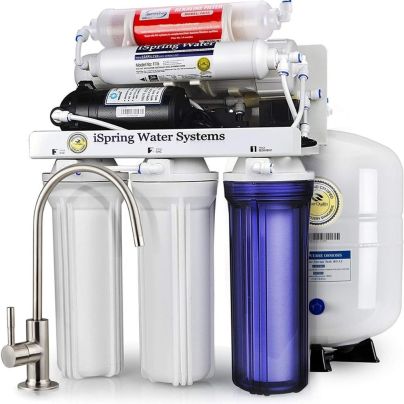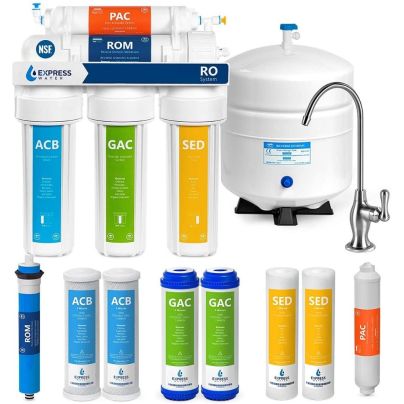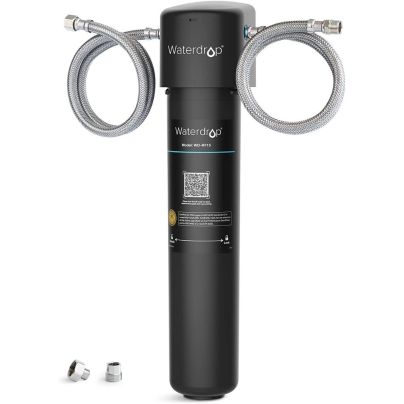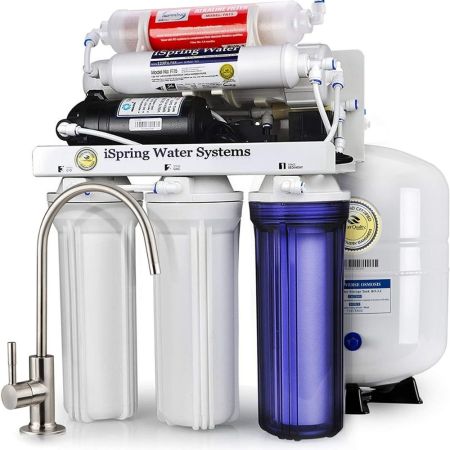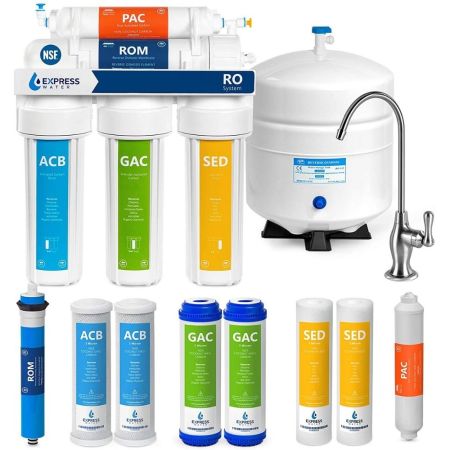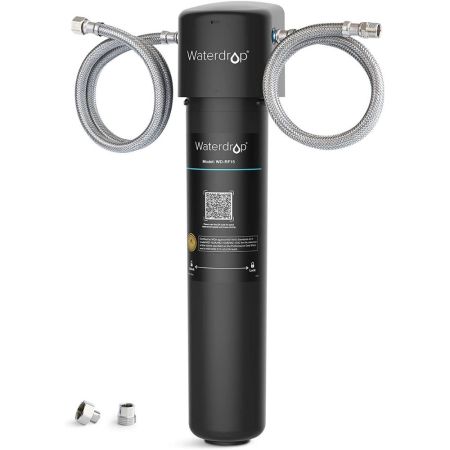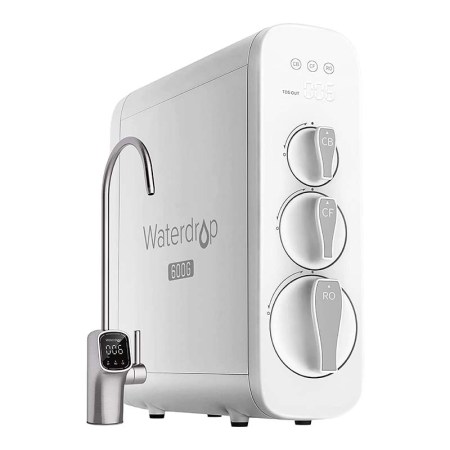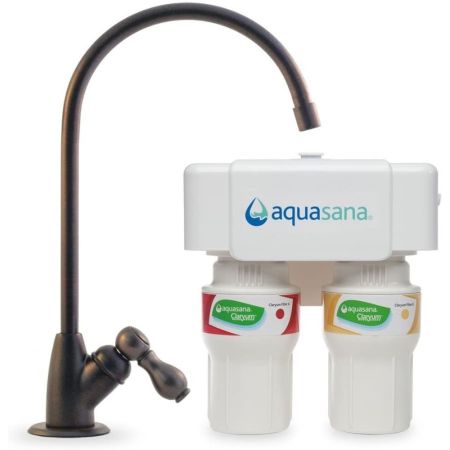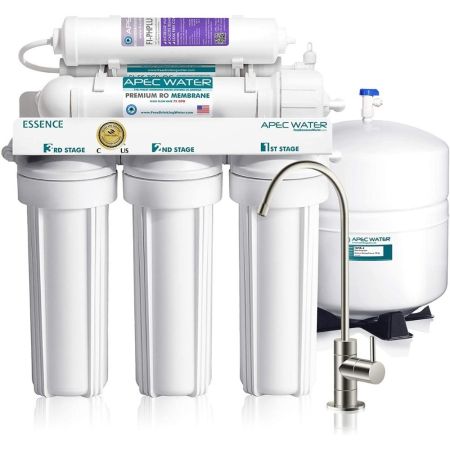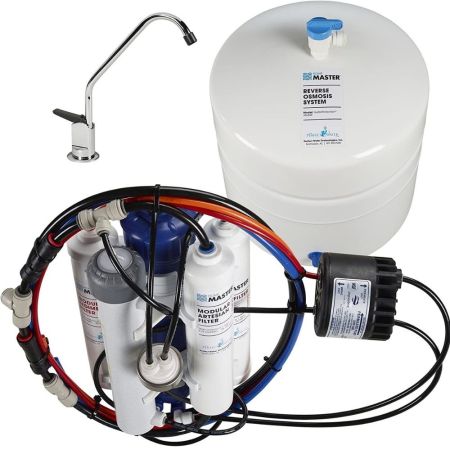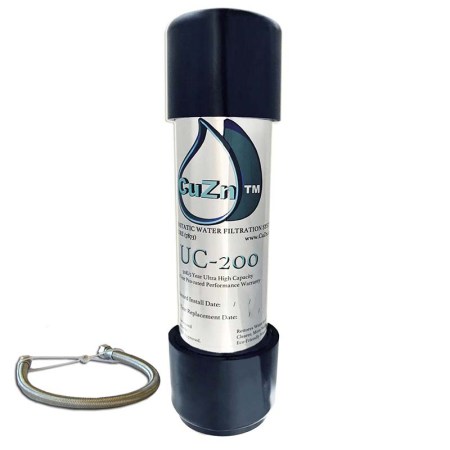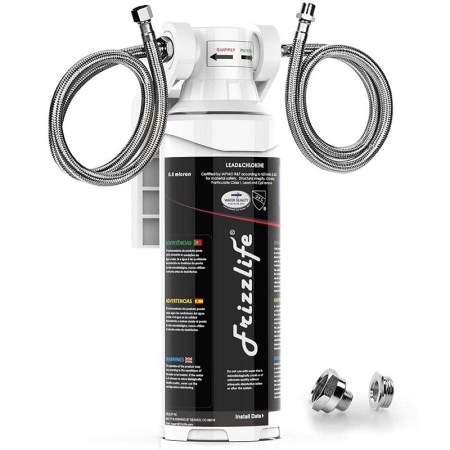We may earn revenue from the products available on this page and participate in affiliate programs. Learn More ›
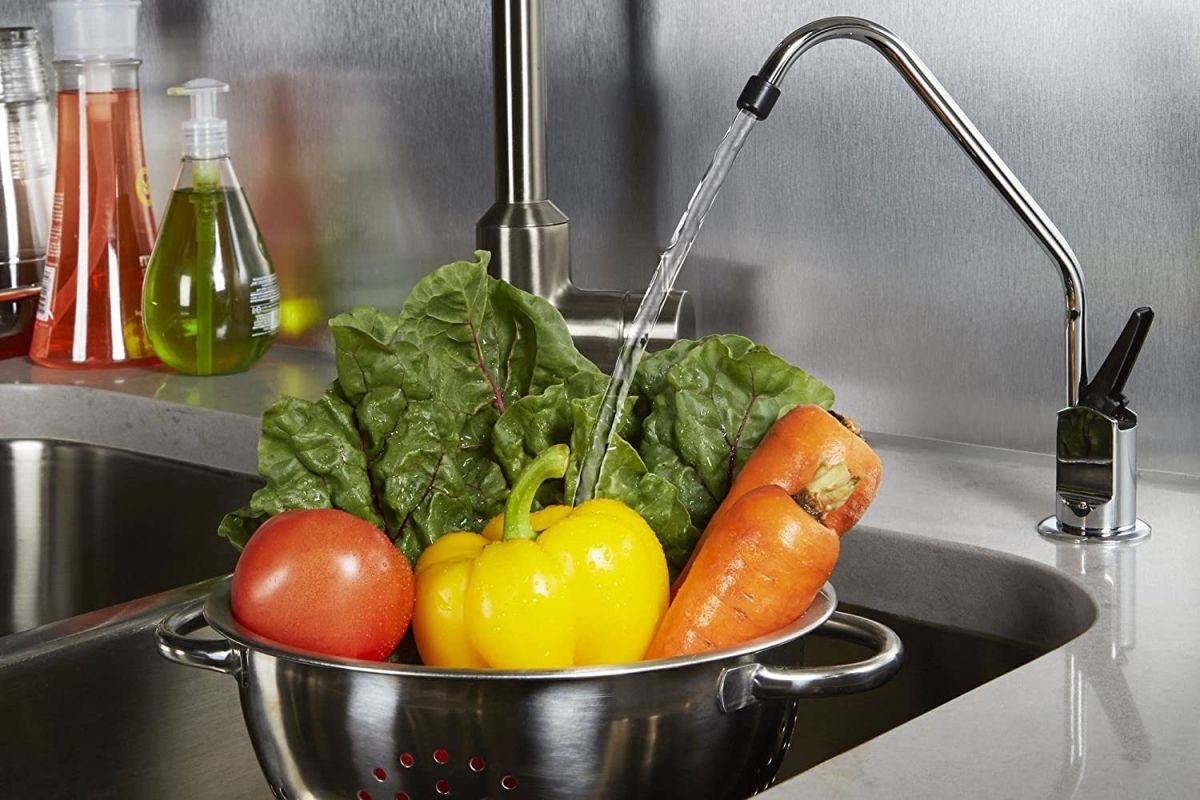
Common tap water may contain contaminants due to the pipes it travels through and chemicals used in the municipal filtration process. If your family wants easy access to a filtered tap water supply for daily drinking and cooking, an under-sink water filtration system is a convenient solution.
Countertop water filters can be effective, but they may also be a bit of an eyesore and take up valuable counter space. Under-counter models keep the mechanics out of sight while providing filtered water right at the kitchen sink. The best under-sink water filters have multiple levels of filtration to offer clean tap water with no hassle.
- BEST OVERALL: iSpring RCC7P-AK 6-Stage Reverse Osmosis System
- RUNNER-UP: Express Water RO5DX Reverse Osmosis Filtration System
- BEST BANG FOR THE BUCK: Waterdrop 15UA Water Filter System
- BEST TANKLESS: Waterdrop Reverse Osmosis System
- BEST FAUCET OPTIONS: Aquasana AQ-5200.62 2-Stage Water Filter System
- BEST FOR ALKALINE WATER: Apec Water Systems ROES-PH75 Water Filter System
- BEST FOR WELL WATER: Home Master TMHP HydroPerfection RO System
- BEST W/O SEPARATE FAUCET: CuZn UC-200 Under Counter Water Filter
- BEST FOR BATHROOM: Frizzlife Under Sink Water Filter System
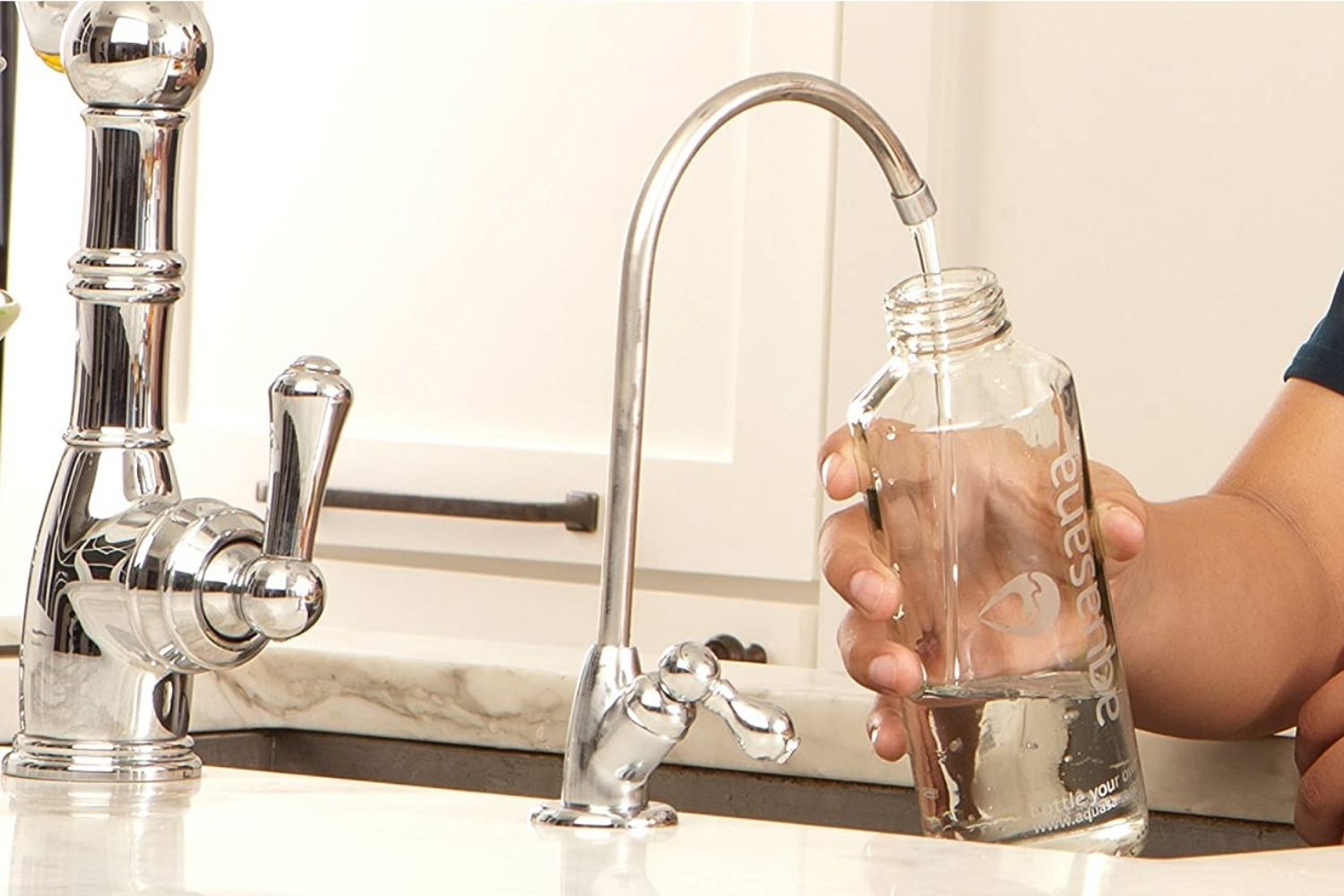
How We Chose the Best Under-Sink Water Filters
After evaluating the key aspects that go into under-sink water filtration—the amount of contaminants removed, physical size of the system, and number of filtration stages—the above list reflects our thorough research into the most suitable products across different price points and filtration types.
We made sure to include several options for under-sink water filter systems that can filter municipal water, well water, and alkaline water to remove over 1,000+ contaminants including chlorine, heavy metals, and bacteria. Some of these under-sink water filters come with countertop faucets, preventing the need for a separate (and potentially more costly) purchase. Select sink filtration systems also stood out for their water-saving designs and built-in pumps that improve water pressure as well as replacement filters.
Our Top Picks
The best under-sink water filters will provide effective filtration, access to ample clean water, and a relatively easy installation. The following under-sink filter systems include these and other features if you’re looking to add the convenience of filtered water at the kitchen sink.
Best Overall
iSpring RCC7P-AK 6-Stage Reverse Osmosis System
See ItProduct Specs
- Type: Reverse osmosis system
- Capacity: 75 gallons
- Flow rate: 75 gallons per day
Pros
- Highly efficient system capable of removing 1,000 contaminants through 6 filtration stages
- Built-in electric booster pump maintains performance regardless of fluctuations in water pressure
- Sixth reverse osmosis filter provides alkaline remineralization for natural water taste
- Installation is made easier by the inclusion of both written instructions and a useful video
Cons
- Requires considerable under-counter space and is expensive compared to other water filtration systems
Talk about thorough: This reverse osmosis (RO) system from iSpring removes up to 99 percent of more than 1,000 contaminants found in tap water, including lead, arsenic, chlorine, fluoride, and asbestos. Its impressive six stages of filtration include sediment and carbon water filters to remove large contaminants and protect the reverse osmosis membrane from chemicals like chlorine and chloramines.
The reverse osmosis system’s filter removes contaminants down to 0.0001 microns so that only water molecules can fit through. An alkaline remineralization filter restores healthy minerals lost in the filtration process, and the last filtration stage gives the water a final polish before being delivered to the included brass faucet, which has a sleek brushed-nickel design.
An electric pump boosts the water pressure so there is less waste during the filtration process, with a ratio of 1 filtered to 1.5 wasted gallons. The water filters need to be replaced every 6 months to a year. Installation can be done by the user with the help of the company’s written and video guides. Live phone support is available for those who run into any problems or have questions not covered by the provided guides.
Get the iSpring under-sink water filter at Amazon, Lowe’s, The Home Depot, or Overstock.
Runner-Up
Express Water RO5DX Reverse Osmosis Filtration System
See ItProduct Specs
- Type: Reverse osmosis and carbon filtration
- Capacity: 4 gallons
- Flow rate: 0.8 gallons per minute
Pros
- A competitively priced system that comes with a set of replacement filters
- Highly efficient 5-stage filtration that removes up to 99.99 percent of contaminants
- Leak detection system shuts off water flow in the event of a fault
- Can produce up to 50 gallons of filtered water per day
Cons
- A few owners report leaks, though it’s difficult to know how well they were fitted
Thanks to a collection of easy-to-install fittings and upgrades, such as ultraviolet, alkaline, and deionization filters, this reverse osmosis system with five stages of filtration is an excellent solution for just about any home that uses municipal water.
In this system, the water first passes through a sediment and two carbon filters before reaching the RO membrane, which removes the finest contaminants. The last stage features a third carbon filter, which aims to eliminate any lingering toxins.
The system is budget-friendly and comes with four replacement water filters, which need to be changed twice a year. One drawback with this system is there is no pump, so water waste comes out to about 1 to 3 gallons.
Get the Express Water under-sink water filter at Amazon or The Home Depot.
Best Bang for the Buck
Waterdrop 15UA Water Filter System
See ItProduct Specs
- Type: Carbon filtration
- Capacity: 16,000 gallons
- Flow rate: 0.75 gallons per minute
Pros
- A budget-friendly system that uses effective 3-stage carbon filtration
- Removes contaminants and heavy metals to NSF/ANSI 372 standard
- Compact design ideal for cramped under-sink spaces and RVs
- Quick 3-minute installation process with simple push-to-connect fittings
Cons
- Does not come with a separate faucet and may impact water-flow rate
Water filtration needn’t cost an arm and a leg, and installing a filtration system doesn’t have to take up precious time. This Waterdrop product is among the most affordable under-sink water filter systems and can be installed in just 3 minutes, making accessing clean tap water a cinch.
This model is also a great option for shoppers who don’t have the cabinet space for a larger water filtration system. The small attachment connects directly to the cold-water line and dispenses carbon-filtered water from the main faucet, reducing odor and pollutants such as chlorine, sediment, rust, and other heavy metals. While it doesn’t eliminate as many contaminants as an RO system, it does retain healthy minerals, like calcium, potassium, and magnesium.
Waterdrop boasts an easy installation with its push-to-connect fittings and a twist-and-lock system that makes changing the under-sink filters easy. For simple upkeep, each filter has a maximum service life of 24 months or 16,000 gallons.
Get the Waterdrop 15UA under-sink water filter at Amazon, Lowe’s, or The Home Depot.
Best Tankless
Waterdrop Reverse Osmosis System
See ItProduct Specs
- Type: Reverse osmosis
- Capacity: 400 gallons
- Flow rate: 400 gallons per day
Pros
- Extremely effective 8-stage filtration process removes a huge range of contaminants
- Built-in water pump reduces water waste and maintains water pressure
- Smart faucet gives instant sink water-quality feedback and warns when filters need to be changed
- A more compact design than many similar RO systems frees up under-counter space
Cons
- The advanced technology is reflected in a higher ticket price than most competitors
Another great option from Waterdrop for kitchens with limited under-sink space, this sleekly designed tankless RO system has a compact footprint without skimping on special features. New technologies make for a smart operation. An internal pump offers faster water flow and less waste with a 1-to-1 ratio of filtered to wastewater, while a leak detector cuts off the water in the event of leaky pipes.
Three under-sink filters provide multiple levels of cleansing, including sediment and carbon-block filters, an RO membrane, and an activated-carbon-block filter, which uses activated-carbon granules made from natural coconut shells to improve water taste. A helpful indicator light will change colors when it is time to replace the filters. Use the included manual or online tutorial to help with installation. Note: The system must be flushed out for 30 minutes before use.
Get the Waterdrop reverse osmosis under-sink water filter at Amazon, Best Buy, or Walmart.
Best Faucet Options
Aquasana AQ-5200.62 2-Stage Water Filter System
See ItProduct Specs
- Type: Carbon filtration
- Capacity: 500 gallons
- Flow rate: 0.5 gallons per minute
Pros
- Choice of 3 high-quality faucet finishes to suit a wide variety of decors
- 2-stage filtration system is capable of filtering 77 different contaminants and has a longfilter life
- Eco-friendly filters have simple twist action for easy replacement without disconnecting water
- Compact design requires a modest amount of under-counter space
Cons
- A number of leaks have been reported, and owners are critical of support
Shoppers interested in incorporating a new faucet with their under-sink water filter should consider this model from Aquasana. Available in three stylish finishes to match a variety of kitchen decors, the system has two stages of filtration and can remove up to 99 percent of 77 different contaminants, including lead and mercury, as well as 97 percent of chlorine and chloramines. The under-sink filters are made to be environmentally friendly with minimal disposable plastic parts.
Since this under-sink water system does not use an RO membrane, there is no water supply wasted, and the filtering process will retain healthy minerals. It has a filter life of around 600 gallons, which can last up to 6 months. Installation can be done by the owner with the help of a detailed manual.
Get the Aquasana under-sink water filter at Amazon.
Best for Alkaline Water
Apec Water Systems ROES-PH75 Water Filter System
See ItProduct Specs
- Type: Reverse osmosis
- Capacity: 75 gallons
- Flow rate: 75 gallons per day
Pros
- High purity filters safely raise alkaline levels in the water and neutralize acidity
- 6-stage filtration removes 99 percent of bacteria, viruses, cysts, organics, chemicals, etc.
- Comprehensive kit includes water tank and high-quality brushed-nickel faucet
- Leak-free quick-connect fittings and valve help simplify and speed up installation
Cons
- As with other multistage water filtration systems, it requires a considerable amount of space
While plain water is just fine for plenty of people, some prefer the taste and purported health benefits of drinking alkaline water. Thanks to a mineral cartridge that adds high-purity calcium carbonate back into the filtered water, alkaline water drinkers can now enjoy this higher pH beverage straight from the tap by using this filter from Apec Water Systems.
In terms of filtration, double-carbon blocks and an RO membrane work to eliminate 99 percent of more than 1,000 contaminants, including chlorine, fluoride, arsenic, lead, and heavy metals. A reliable choice, this under-sink filtration systemhas been certified by the Water Quality Association, which ensures high-quality water filtration products.
A sleek brushed-nickel faucet is included with the filter. Keep in mind that there is water waste to consider with this filter, as it has a slightly high 1- (filtered) to 3- (waste) gallon ratio. Videos and a manual are available for those who opt for DIY installation.
Get the Apec Water Systems under-sink water filter at Amazon, Lowe’s, or The Home Depot.
Best for Well Water
Home Master TMHP HydroPerfection RO System
See ItProduct Specs
- Type: Reverse osmosis
- Capacity: 2,000 gallons
- Flow rate: 50 gallons per day
Pros
- EPA registered to kill, inactivate, or suppress growth of viruses, bacteria, and fungi
- 9 stages of filtration, purification, and UV sterilization remove up to 99 percent of contaminants
- Adds calcium carbonate and magnesium to balance water pH and deliver great-tasting water
- Built-in nonelectric permeate pump reduces water waste to about a 1:1 ratio
Cons
- Expensive and requires a considerable amount of under-counter space
Although well water isn’t treated with chemicals like chlorine, it can contain contaminants like sand, rust, and heavy metals. It can also be rich in iron, which sometimes contains harmful bacteria. Therefore, households that have well water require a filtration system that can stand up to these contaminants and toxins.
The EPA-registered under-sink water system from Home Master uses a whopping seven stages of filtration, including an iron prefilter and a ultraviolet (UV) light sterilizer to remove up to 99 percent of iron, hydrogen sulfide, heavy metals, and thousands of other contaminants. A remineralization process adds in healthy minerals, including small amounts of calcium and magnesium.
The filter is made to last for up to 2,000 gallons of water, which equals about 1 year of standard water usage. It includes a DIY installation with a detailed manual.
Get the Home Master under-sink water filter at Amazon, Lowe’s, or The Home Depot.
Best W/O Separate Faucet
CuZn UC-200 Under Counter Water Filter
See ItProduct Specs
- Type: Micro-sediment membrane and coconut shell carbon
- Capacity: 50,000 gallons
- Flow rate: 2 gallons per minute
Pros
- No tank or pump; just connects to the cold supply of an existing faucet
- 3-stage filtration stops inorganic and organic contaminants, and prevents bacterial growth
- Compact and easy to fit leaving plenty of space under most sinks
- Each long-life filter is expected to last 5 years before it needs changing
Cons
- This type of filter is not recommended for use with well water
The challenge with many under-sink water filters is the need to drill an additional hole through the countertop to fit a new faucet. Access can be awkward, and many people prefer not to have a separate faucet. This CuZn product is an alternative that’s been proven over more than 20 years. It fits quickly and easily to the existing cold water supply and takes up minimal space under the sink.
Three-way filtration uses micro-sediment membrane, activated carbon from coconut shells, and a special KDF-55 medium that specifically targets chlorine and water-soluble heavy metals. Together they effectively reduce organic and nonorganic contaminants, with filters lasting 5 years between changes.
Unfortunately, this type of filter isn’t effective at removing total dissolved solids (TDS) and should not be used to filter well water.
Get the CuZn under-sink water filter at Amazon or Walmart.
Best for Bathroom
Frizzlife Under Sink Water Filter System
See ItProduct Specs
- Type: Carbon filtration
- Capacity: N/A
- Flow rate: 2 gallons per minute
Pros
- 2-GPM flow rate has minimal impact on low-pressure bathroom faucets
- Compatible with both ⅜- and ½-inch connectors with extra adapters included
- Meets NSF standards for removal of fluoride, cyst, lead, and arsenic
- The pricing is very competitive, and it also has economical replacement filters
Cons
- Canisters are larger than some expected, and it should not be used with well water.
Bathroom faucets tend to have lower flow rates than kitchen models, and there’s a danger that multistage water filters will restrict that even further. Many bathroom vanity cabinets also have less free space than those under kitchen sinks. The Frizzlife under-sink water filter offers a solution that addresses both these issues.
Flow rate is 2 gallons per minute (GPM), which is the equivalent of filling a standard 11-ounce cup in just 3 seconds. The single filter unit fits quickly to the existing cold-water supply line so there’s no bulky tank or pump. The two-stage 0.5-micron carbon compound meets National Sanitation Foundation standards for safe water removing fluoride, lead, and arsenic while allowing beneficial minerals to pass through. Only the filter needs to be changed, not the outer canister, further reducing costs.
As is the case with most carbon filters, the Frizzlife is not recommended for well water. An RO system should be chosen instead.
Get the Frizzlife under-sink water filter at Amazon or Walmart.
Jump to Our Top Picks
What to Consider When Choosing an Under-Sink Water Filter
There are plenty of options available when it comes to water filtration. The best under-sink filtration system should suit your own space, capacity, and installation needs while providing easy access to clean water. Other things to consider while shopping include types and levels of filtration, water flow and pressure, odor removal, and water waste.
Types of Under-Sink Water Filters
Options for under-sink water filters range from a simple attachment for an existing cold-water line and faucet to a more complex multistage system. Common types include reverse osmosis, ultrafiltration (UF), and carbon water filters.
Reverse Osmosis
RO systems flush contaminants from the water supply to deliver filtered water through a separate faucet. RO systems work by pushing water through a membrane with pores so small that only water molecules can pass through, eliminating more than 1,000 toxins such as chlorine, fluoride, and heavy metals as well as bacteria and pesticides.
The most effective versions of RO systems have multiple levels of filtration, including carbon water filters, so they may take up a considerable amount of cabinet space and include a moderately complex DIY installation.
Ultrafiltration (UF)
Ultrafiltration uses a hollow fiber membrane to stop debris and contaminants from entering the water. Though it doesn’t eliminate as many toxins as an RO system, it will preserve healthy minerals that are eliminated in water filtration systems where only water molecules can pass through.
It is also easier to install, as it generally works as an addition to the existing faucet. However, since it attaches to the main faucet, the filter life may be shorter than systems with a separate fixture.
Carbon Filters
A carbon filter is the most basic option when it comes to filtration, but still very effective. It is used in various systems from simple water pitchers to advanced multilevel systems. Activated carbon will chemically bond with contaminants, removing them as water flows through the filter.
The effectiveness of a carbon filter alone will vary, so look for the level of filtration noted on the product, including the contaminants it will remove. An RO system combined with a carbon filter is generally the best under-sink water filter systems for eliminating toxins from tap water supply.
Size and Capacity
The size and type of water filtration you need will depend on the amount of filtered water required by a household each day. For those who live alone, a pitcher or simple under-sink attachment should suffice. For large families who tend to use a lot of filtered drinking or cooking water, an RO system can easily filter anywhere from 50 to 75 gallons of water per day.
Although larger-capacity filtering cartridges require replacement less frequently, they take up more space beneath the sink, especially RO systems that come with a tank. If you have limited cabinet space, this is an important consideration.
Flow Rate
The flow rate measures how quickly water is dispensed from the faucet. This will impact how long it takes to fill a glass or a pot for cooking. The more levels of filtration, the slower the water will flow from the faucet, so companies work hard in this area to offer faster flow as a selling point. RO systems have a separate faucet; however, for under-sink filters that use the main faucet, users may notice a very slight reduction in water flow.
The rate is calculated by gallons per minute and, depending on the product, will typically range from 0.8 to 2 GPM. The flow rate is not only dictated by the product, but also by the pressure of the home’s water supply and the number of people using it.
Water Pressure
While flow rate is reflected by speed, water pressure is determined by force. Very low water pressure will inhibit proper filtration through RO under-sink filters since the system relies on pressure to force water molecules through the membrane. A home’s water pressure is measured in pounds-per-square-inch (psi).
Many large under-sink filters will require a minimum of 40 to 45 psi to be effective. For a standard household, the maximum psi will normally be 60. Water pressure will also be affected by the square footage of the house as well as the number of users within the household.
Odor Removal
According to a recent Consumer Reports survey, nearly half of Americans who drink municipal water complained of an odor coming from their tap water. Though the odor doesn’t always mean something is wrong, it can make hydrating less appealing.
Chlorine, a chemical used in water-treatment facilities to rid the water of bacteria, viruses, and parasites, is one of the most common contributors to the smell. Fortunately, most under-sink water filters, even pitchers, will help to reduce the odor and enhance the taste. The higher level of filtration, the more efficient the system will be at removing both the contaminants and the resulting odor.
Faucet Attachment
As previously mentioned, many RO under-sink filters will include a separate faucet. Many drop-in sinks will include prefabricated holes—some may need to be punched out—that can accommodate a secondary faucet.
However, others will require a new hole to be drilled, which may be a drawback for some. Shoppers may also want to take note of the style of the faucet to make sure it works with their design aesthetic. Most feature a slim silhouette in brass and are finished with brushed nickel or chrome. Some manufacturers will offer a choice of finishes.
Installation
Water filtration system installation ranges from a simple DIY project that takes minutes to a more detailed job that may require professional help, depending on the individual’s level of handiness. Those using the main faucet as the water source will require less time and sweat for installation, which usually entails attaching the filter to the cold-water line.
Though still simpler than a whole-house water filtration system, RO under-sink filters with a separate water dispenser can be more involved. Depending on whether there is a predrilled hole available for an extra faucet and how much space is available under the sink, a system can take minutes or hours to install. Many companies will offer guides, videos, or phone support to help with the process.
Water Waste
One drawback to RO systems is that a decent portion of water may be wasted during the filtering process when waste is flushed away. Some systems have a ratio as high as 3 gallons wasted to 1 filtered. Thanks to new technologies, such as a special pump called a permeate pump to increase water pressure, this waste is reduced. Others will include a setting to use wastewater for nondrinking purposes. Shoppers will want to aim for a low waste-to-pure water ratio.
FAQs
You may still be wondering about which under-sink water filter removes the most contaminants, how to choose the right under-sink water filter for your home, and how often an under-sink water filter needs to be changed. Read on for the answers to these and other commonly asked questions about under-sink water filters.
Q. Which water filter removes the most contaminants?
The number of stages and the filter mediums all have an impact on the removal of contaminants. Generally speaking, a multistage reverse osmosis water filtration system combined with a carbon filter is the most effective option for removing as many contaminants as possible. However, these water filters also tend to be larger than other options, and more compact models can be very nearly as efficient.
Q. How do I choose an under-sink water filter?
There are numerous decisions involved in finding the best under-sink water filter for a particular installation, and the information above is designed to help buyers make the right choice. In a nutshell, there are three important things to consider: the amount of under-counter space available, the amount of filtration desired, and the difficulty of the installation you’re willing to take on (or how much it’s likely to cost if a professional is hired).
Q. How often should I change my under-sink filter?
The time frame for changing your under-sink filter will depend on the model you choose and the type of filter. It is important to read the manufacturer’s instructions to ensure maximum efficiency. Leaving them unchanged for too long may result in contaminants reappearing in the water and can also reduce the water flow. Most under-sink filters will have a lifespan of 6 months to a year, though longer periods are possible, particularly with carbon-based filters. In high-usage commercial settings, these times may be reduced.
Why Trust Bob Vila
Bob Vila has been America’s Handyman since 1979. As the host of beloved and groundbreaking TV series including “This Old House” and “Bob Vila’s Home Again,” he popularized and became synonymous with “do-it-yourself” home improvement.
Over the course of his decades-long career, Bob Vila has helped millions of people build, renovate, repair, and live better each day—a tradition that continues today with expert yet accessible home advice. The Bob Vila team distills need-to-know information into project tutorials, maintenance guides, tool 101s, and more. These home and garden experts then thoroughly research, vet, and recommend products that support homeowners, renters, DIYers, and professionals in their to-do lists.
